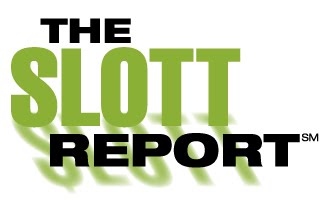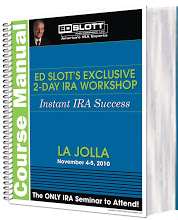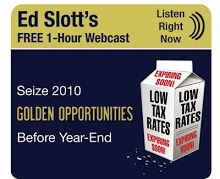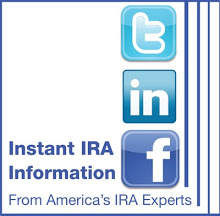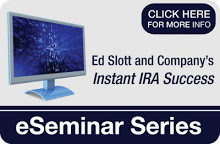The Wisconsin Law Journal published a November 30, 2009 article about the impending end of income limits on Roth IRAs. As of January 1, 2010, individuals with an adjusted gross income exceeding $100,000 can convert an existing IRA or 401(k) account into a Roth IRA.
Ed Slott told Correy E. Stephenson, "This is great for lawyers and their for clients. (For a lot of people) their largest single asset is their 401(k) or IRA plan and doing a conversion to a Roth can have a huge impact."
CLICK HERE to read the article in its entirety.
Compiled by Jared Trexler
------------------------------------------------------------------------------
Comment, Question, Discussion Topic on your mind? Click on the Blue Comment Linkbelow and leave your thoughts then check back to see what other consumers and advisors think.
*Copyright 2009 Ed Slott and Company, LLC
Monday, November 30, 2009
Wednesday, November 25, 2009
Last Chance to Rollover an Unwanted 2009 RMD
The November 30th deadline for rolling over 2009 RMD amounts that were taken earlier this year is fast approaching.
Required minimum distributions were waived for 2009. In some cases automatic distributions were made to taxpayers before they could be shut off. Not all RMD recipients realized that they could simply roll those distributions back to the distributing account or to an IRA within 60 days.
IRS released guidance in Notice 2009-82 allowing most taxpayers to roll those distributions over. But you only have until November 30, 2009 to roll over a qualifying distribution.
Plan participants can roll over any distribution that contains all or part of what would have been a 2009 RMD.
IRA account owners who have not done a 60-day rollover in the last 12 months from the distributing IRA can roll over one distribution that contains all or part of what would have been a 2009 RMD.
Non-spouse beneficiaries of inherited accounts cannot roll over any 2009 distributions since they are prohibited by the tax code from doing a 60-day rollover.
You should check with your advisor or tax preparer to determine if your distribution is eligible for this rollover relief.
By IRA Technical Consultant Beverly DeVeny and Jared Trexler
------------------------------------------------------------------------------
Comment, Question, Discussion Topic on your mind? Click on the Blue Comment Linkbelow and leave your thoughts then check back to see what other consumers and advisors think.
*Copyright 2009 Ed Slott and Company, LLC
------------------------------------------------------------------------------
Comment, Question, Discussion Topic on your mind? Click on the Blue Comment Linkbelow and leave your thoughts then check back to see what other consumers and advisors think.
*Copyright 2009 Ed Slott and Company, LLC
Monday, November 23, 2009
Self-Directed IRA Investments
If you are considering a self-directed IRA, you have probably done some research, talked to others who are doing this type of investing, seen articles in magazines, or looked on the Internet for information. Many sales pitches will say that their investment, strategy, or product is approved by IRS, giving you the sense that you have nothing to worry about if you do business with them. Not necessarily so!
If you look very closely at what is said in many of those ads, you will see that what they are really saying is that the IRA document or plan agreement is approved by IRS. This is true of all IRAs and employer plans. They must have an IRS-approved document. But the document is the only part that is IRS approved. Despite the fancy advertising and creative marketing material, the underlying investment or investement strategy is NOT IRS approved.
Not convinced? IRS has even put out a publication (really it's more of a brochure) on this subject. Check out IRS Publication 3125 on their website, www.irs.gov. On the left side of the screen, click on Forms and Publications. This is the IRS rebuttal to the claims made by slick promoters.
By IRA Technical Consultant Beverly DeVeny and Jared Trexler
------------------------------------------------------------------------------
Comment, Question, Discussion Topic on your mind? Click on the Blue Comment Link below and leave your thoughts then check back to see what other consumers and advisors think.
*Copyright 2009 Ed Slott and Company, LLC
If you look very closely at what is said in many of those ads, you will see that what they are really saying is that the IRA document or plan agreement is approved by IRS. This is true of all IRAs and employer plans. They must have an IRS-approved document. But the document is the only part that is IRS approved. Despite the fancy advertising and creative marketing material, the underlying investment or investement strategy is NOT IRS approved.
Not convinced? IRS has even put out a publication (really it's more of a brochure) on this subject. Check out IRS Publication 3125 on their website, www.irs.gov. On the left side of the screen, click on Forms and Publications. This is the IRS rebuttal to the claims made by slick promoters.
By IRA Technical Consultant Beverly DeVeny and Jared Trexler
------------------------------------------------------------------------------
Comment, Question, Discussion Topic on your mind? Click on the Blue Comment Link below and leave your thoughts then check back to see what other consumers and advisors think.
*Copyright 2009 Ed Slott and Company, LLC
Friday, November 20, 2009
Question of the Week: 3 Steps to Creditor Protection
This week the Ed Slott and Company IRA Discussion Forum featured a question about the creditor protection of single member company plans. Want to know how protected your retirement assets are from the potential claims of creditors? Read on to find out.
For many individuals, creditor protection is not a big concern, but for those that have this concern, it's important to understand all of the rules. If creditor protection is important to you, here's an easy three step Q and A to help you determine how protected your retirement assets are from the potential claims of creditors.
Question #1 -- Are the assets part of a company plan that is covered under ERISA?
If the answer to this question is yes then you likely (see Question #2 as well) have excellent creditor protection. ERISA law covers company plan money regardless of where you live. Under this law, plan money has federal creditor protection. Not sure if your plan is covered under ERISA? You can ask for a copy of the plan document or summary plan description which would generally include this information. If you don't see it there, you may want to call the plan provider and ask them.
Question #2 -- If the answer to Question #1 is yes, is there more than one plan participant?
If the answer is no, or if the only participants are the business owner and his/her spouse, the plan is no longer covered under ERISA. The "E" in ERISA stands for employees. No employees.....no ERISA coverage. Makes sense right? But that isn't necessarily a bad thing. The assets may still receive creditor protection under state law (see Question #3).
Question #3 -- What is the law in your state?
IRAs and single member company plans receive creditor protection at the state level. State law varies, so it's important to know the law where you live. In many states, the creditor protection for IRAs is as strong as the protection afforded under ERISA. There are a few states, though, that do not offer such protection. If this is a big issue for you, you may want to speak with an advisor who has specialized knowledge in this area.
Got more questions? Want to see what other people are asking? Check out the Ed Slott and Company IRA Discussion Forum.
By IRA Technical Consultant Jeffrey Levine and Jared Trexler
------------------------------------------------------------------------------
Comment, Question, Discussion Topic on your mind? Click on the Blue Comment Link below and leave your thoughts then check back to see what other consumers and advisors think.
*Copyright 2009 Ed Slott and Company, LLC
For many individuals, creditor protection is not a big concern, but for those that have this concern, it's important to understand all of the rules. If creditor protection is important to you, here's an easy three step Q and A to help you determine how protected your retirement assets are from the potential claims of creditors.
Question #1 -- Are the assets part of a company plan that is covered under ERISA?
If the answer to this question is yes then you likely (see Question #2 as well) have excellent creditor protection. ERISA law covers company plan money regardless of where you live. Under this law, plan money has federal creditor protection. Not sure if your plan is covered under ERISA? You can ask for a copy of the plan document or summary plan description which would generally include this information. If you don't see it there, you may want to call the plan provider and ask them.
Question #2 -- If the answer to Question #1 is yes, is there more than one plan participant?
If the answer is no, or if the only participants are the business owner and his/her spouse, the plan is no longer covered under ERISA. The "E" in ERISA stands for employees. No employees.....no ERISA coverage. Makes sense right? But that isn't necessarily a bad thing. The assets may still receive creditor protection under state law (see Question #3).
Question #3 -- What is the law in your state?
IRAs and single member company plans receive creditor protection at the state level. State law varies, so it's important to know the law where you live. In many states, the creditor protection for IRAs is as strong as the protection afforded under ERISA. There are a few states, though, that do not offer such protection. If this is a big issue for you, you may want to speak with an advisor who has specialized knowledge in this area.
Got more questions? Want to see what other people are asking? Check out the Ed Slott and Company IRA Discussion Forum.
By IRA Technical Consultant Jeffrey Levine and Jared Trexler
------------------------------------------------------------------------------
Comment, Question, Discussion Topic on your mind? Click on the Blue Comment Link below and leave your thoughts then check back to see what other consumers and advisors think.
*Copyright 2009 Ed Slott and Company, LLC
Thursday, November 19, 2009
Slott Report Mailbag: November 19th
As Thanksgiving approaches, here is this week's Slott Report Mailbag.
1.
Dear Ed and Company,
Is there any tax advantage of converting a "non-deductible" IRA to a Roth IRA vs. a traditional deductible IRA to a Roth IRA? I'm asking because the non-deductible has "original" cost basis, which is tax-free, and it would seem to make sense to convert as much non-deductible IRA as possible, but only if the conversion implies no taxation. Can you clarify please?
Thanks!
Answer:
You have a good idea - convert a non-deductible IRA to a Roth IRA. Unfortunately it does not work that way unless that is the only IRA you have and all the money in that IRA is non-deductible. There is a little known rule called the "pro-rata rule", which states that when an IRA contains both non-deductible and deductible funds, then each dollar withdrawn or converted from the IRA will contain a percentage of tax free and taxable funds. The same is true even if you have separate IRAs with non-deductible and deductible contributions. All IRAs must be considered for the pro-rata rule, including SEP and SIMPLE IRAs. Bottom line is you cannot just withdraw or convert the non-deductible funds and pay no income tax even if the non-deductible IRA contributions were kept in a separate IRA.
2.
In Bottom Line Retirement, you describe taking company stock from a 401(k) "in kind", also known, I think, as "unrealized net appreciation", whereby you are taxed on the stock's value when the company gave it to you. I am encountering various interpretations of this, can you clarify? My company says that any prior distribution from the plan disqualifies this advantage. The actual wording just says that the entire plan must be rolled over within one calendar year. This means that even a previous RMD would disqualify if my company is right. Even the IRS does not seem to know the answer; talked to them on the phone. Seems to me that whatever is in fund during a taxable year constitutes the entire plan, regardless of a past year partial withdraw. Can you help?
Answer:
It sounds like your company is giving you good advice. If you have low cost basis in your company stock held in your 401(k) plan versus the current market value, using net unrealized appreciation (NUA) could be beneficial. However, the rules regarding NUA are a little tricky. First of all, you need a triggering event, such as separation from service, and the company stock comes out as part of a lump-sum distribution in one tax year to use the NUA advantage. The problem is the definition of a lump-sum distribution. All funds must be withdrawn within one tax year. Distributions in prior years mean that you cannot meet the criteria of doing the withdrawal in one year. If you are 70 1/2 or older and taking required minimum distributions, there would need to be a new triggering event and unfortunately death would be the only triggering event left, assuming you have already separated from service. In that case your heirs would be able to use the NUA advantage.
By IRA Technical Consultant Marvin Rotenberg and Jared Trexler
------------------------------------------------------------------------------
Comment, Question, Discussion Topic on your mind? Click on the Blue Comment Link below and leave your thoughts then check back to see what other consumers and advisors think.
*Copyright 2009 Ed Slott and Company, LLC
1.
Dear Ed and Company,
Is there any tax advantage of converting a "non-deductible" IRA to a Roth IRA vs. a traditional deductible IRA to a Roth IRA? I'm asking because the non-deductible has "original" cost basis, which is tax-free, and it would seem to make sense to convert as much non-deductible IRA as possible, but only if the conversion implies no taxation. Can you clarify please?
Thanks!
Answer:
You have a good idea - convert a non-deductible IRA to a Roth IRA. Unfortunately it does not work that way unless that is the only IRA you have and all the money in that IRA is non-deductible. There is a little known rule called the "pro-rata rule", which states that when an IRA contains both non-deductible and deductible funds, then each dollar withdrawn or converted from the IRA will contain a percentage of tax free and taxable funds. The same is true even if you have separate IRAs with non-deductible and deductible contributions. All IRAs must be considered for the pro-rata rule, including SEP and SIMPLE IRAs. Bottom line is you cannot just withdraw or convert the non-deductible funds and pay no income tax even if the non-deductible IRA contributions were kept in a separate IRA.
2.
In Bottom Line Retirement, you describe taking company stock from a 401(k) "in kind", also known, I think, as "unrealized net appreciation", whereby you are taxed on the stock's value when the company gave it to you. I am encountering various interpretations of this, can you clarify? My company says that any prior distribution from the plan disqualifies this advantage. The actual wording just says that the entire plan must be rolled over within one calendar year. This means that even a previous RMD would disqualify if my company is right. Even the IRS does not seem to know the answer; talked to them on the phone. Seems to me that whatever is in fund during a taxable year constitutes the entire plan, regardless of a past year partial withdraw. Can you help?
Answer:
It sounds like your company is giving you good advice. If you have low cost basis in your company stock held in your 401(k) plan versus the current market value, using net unrealized appreciation (NUA) could be beneficial. However, the rules regarding NUA are a little tricky. First of all, you need a triggering event, such as separation from service, and the company stock comes out as part of a lump-sum distribution in one tax year to use the NUA advantage. The problem is the definition of a lump-sum distribution. All funds must be withdrawn within one tax year. Distributions in prior years mean that you cannot meet the criteria of doing the withdrawal in one year. If you are 70 1/2 or older and taking required minimum distributions, there would need to be a new triggering event and unfortunately death would be the only triggering event left, assuming you have already separated from service. In that case your heirs would be able to use the NUA advantage.
By IRA Technical Consultant Marvin Rotenberg and Jared Trexler
------------------------------------------------------------------------------
Comment, Question, Discussion Topic on your mind? Click on the Blue Comment Link below and leave your thoughts then check back to see what other consumers and advisors think.
*Copyright 2009 Ed Slott and Company, LLC
Tuesday, November 17, 2009
Retirement Fears: IRS Grants Relief
What is keeping you up at night?
The Worker, Retiree, and Employer Recovery Act of 2008 signed into law on December 23, 2008 suspended required minimum distributions (RMDs) for 2009 for IRA owners and beneficiaries of inherited IRAs. Since this Act came out late in the year, many individuals received distributions and were not able to roll them over timely due to confusion over the rules.
On September 24, 2009 the IRS issued Notice 2009-82 allowing IRA owners to put back unwanted RMDs for 2009.
Generally an RMD is not eligible to be rolled over to an IRA. Because there are no RMDs for 2009, any money taken out that would have been an RMD could be rolled over to an IRA or rolled back into the same IRA. Prior to IRS Notice 2009-82 an individual had 60 days to put rollover eligible distributions into an IRA after receipt. IRS Notice 2009-82 extended the 60 day rollover period and allows an individuals to put back the funds into an IRA up to November 30, 2009.
This extension does not apply to amounts in excess of what would have been the 2009 RMD amount if there were RMDs in 2009. It also does not apply to IRA beneficiaries. A non-spouse beneficiary can never do a 60-day rollover.
Another IRS regulation states that you can only do one rollover from any one IRA per 12 months and that rule is unchanged. For example, an individual that was taking monthly or quarterly distributions for their RMD in 2009 could only do a rollover for one of those distributions under this relief. No more than one distribution per IRA, per year will be eligible for a rollover. If an individual did a rollover of any distributed amounts already this year, they cannot do another rollover for the RMD amount.
November 30, 2009 is fast approaching, so time is of the essence for these individuals to rollover what they thought was an RMD for 2009. If the money is rolled over there would be no income tax due on that amount.
CLICK HERE to read the Retirement Fears scenario and questions to ask your financial advisor.
The Worker, Retiree, and Employer Recovery Act of 2008 signed into law on December 23, 2008 suspended required minimum distributions (RMDs) for 2009 for IRA owners and beneficiaries of inherited IRAs. Since this Act came out late in the year, many individuals received distributions and were not able to roll them over timely due to confusion over the rules.
On September 24, 2009 the IRS issued Notice 2009-82 allowing IRA owners to put back unwanted RMDs for 2009.
Generally an RMD is not eligible to be rolled over to an IRA. Because there are no RMDs for 2009, any money taken out that would have been an RMD could be rolled over to an IRA or rolled back into the same IRA. Prior to IRS Notice 2009-82 an individual had 60 days to put rollover eligible distributions into an IRA after receipt. IRS Notice 2009-82 extended the 60 day rollover period and allows an individuals to put back the funds into an IRA up to November 30, 2009.
This extension does not apply to amounts in excess of what would have been the 2009 RMD amount if there were RMDs in 2009. It also does not apply to IRA beneficiaries. A non-spouse beneficiary can never do a 60-day rollover.
Another IRS regulation states that you can only do one rollover from any one IRA per 12 months and that rule is unchanged. For example, an individual that was taking monthly or quarterly distributions for their RMD in 2009 could only do a rollover for one of those distributions under this relief. No more than one distribution per IRA, per year will be eligible for a rollover. If an individual did a rollover of any distributed amounts already this year, they cannot do another rollover for the RMD amount.
November 30, 2009 is fast approaching, so time is of the essence for these individuals to rollover what they thought was an RMD for 2009. If the money is rolled over there would be no income tax due on that amount.
CLICK HERE to read the Retirement Fears scenario and questions to ask your financial advisor.
By IRA Technical Consultant Marvin Rotenberg and Jared Trexler
---------------------------------------------------------------------
Comment, Question, Discussion Topic on your mind? Click on the Blue Comment Link below and leave your thoughts then check back to see what other advisors and consumers think.
*Copyright 2009 Ed Slott and Company, LLC
Monday, November 16, 2009
Leaving Your Job? Avoid These Costly Mistakes
Mary Spurrier wrote a guest article for the Rochester Democrat and Chronicle about important information to know when leaving a job.
One of the main points was to: "take a direct rollover to avoid the 20 percent withholding rules. If you forget, you have only 60 days to replace the money with personal funds. You can then roll over the entire amount, avoiding taxes and possible penalties."
Ed Slott and Company IRA Technical Consultant Beverly DeVeny said: "Make sure you talk to your HR or employee benefit department about your rollover before transferring any money."
CLICK HERE to read the entire article.
Compiled by Jared Trexler
-----------------------------------------------------------------------------------
Comment, Question or Discussion Topic on your mind? Click on the Blue Comment Link below and leave your thoughts then check back to see what other advisors and consumers think.
One of the main points was to: "take a direct rollover to avoid the 20 percent withholding rules. If you forget, you have only 60 days to replace the money with personal funds. You can then roll over the entire amount, avoiding taxes and possible penalties."
Ed Slott and Company IRA Technical Consultant Beverly DeVeny said: "Make sure you talk to your HR or employee benefit department about your rollover before transferring any money."
CLICK HERE to read the entire article.
Compiled by Jared Trexler
-----------------------------------------------------------------------------------
Comment, Question or Discussion Topic on your mind? Click on the Blue Comment Link below and leave your thoughts then check back to see what other advisors and consumers think.
Friday, November 13, 2009
Wall Street Journal: The 5-Year Rule and Roths
The Wall Street Journal's Kelly Greene recently answered a reader's question about the five-year rule on Roth IRA conversions.
Greene wrote: "For withdrawals to be penalty free, the five-year rule governing Roth IRAs for the most part works the same for people who open and begin periodic contributions to a Roth IRA and those who convert to a Roth from a traditional individual retirement account or other retirement plan."
However, as Greene pointed out, there is a wrinkle or two. CLICK HERE to read the entire Q&A to find them out.
Greene also asked Ed Slott to explain some of the intricate measures to look for when working with the five-year rule and Roth IRA conversions.
CLICK HERE to read the article in its entirety.
Compiled by Jared Trexler
------------------------------------------------------
Comment, Question, Discussion Topic on your mind? Click on the Blue Comment Link below and leave your thoughts then check back to see what other advisors and consumers think.
Greene wrote: "For withdrawals to be penalty free, the five-year rule governing Roth IRAs for the most part works the same for people who open and begin periodic contributions to a Roth IRA and those who convert to a Roth from a traditional individual retirement account or other retirement plan."
However, as Greene pointed out, there is a wrinkle or two. CLICK HERE to read the entire Q&A to find them out.
Greene also asked Ed Slott to explain some of the intricate measures to look for when working with the five-year rule and Roth IRA conversions.
CLICK HERE to read the article in its entirety.
Compiled by Jared Trexler
------------------------------------------------------
Comment, Question, Discussion Topic on your mind? Click on the Blue Comment Link below and leave your thoughts then check back to see what other advisors and consumers think.
Thursday, November 12, 2009
Slott Report Mailbag: November 13th
Below is another Slott Report Mailbag.
1.
If you elect to convert an IRA to a Roth in the year 2010, when do you pay the taxes? Is it all due in the year 2010, is any of it due in the year 2010? Or do you pay the taxes in the year 2011 and 2012? Also, what is the tax rate? Is it based upon your 2010 tax return or is the tax rate based upon your 2011 or 2012 tax return?
Thanks,
Kathy Lane
Answer:
If you convert in 2010 you have the option to pay the tax due on the conversion in 2010 or if you don't pay it in 2010 you can pay the taxes in 2011 and 2012. If you decide to pay the tax in 2011 and 2012, you would report half the conversion amount in 2011 and the other half in 2012. The tax due would be based on your tax rate in those years. If you pay the tax in 2010, the tax would also be based on your tax rate in that year.
2.
The general rule for electing to take RMDs from a non-spouse inherited IRA is that one must begin distributions by the end of the calendar year following the owner's death. But there is also a special rule saying that RMDs from IRAs are suspended for 2009.
Does this mean that for deaths in 2008, a beneficiary may defer the (implicit) declaration to take RMDs until 2010 because there is no requirement to take an RMD in 2009? Or is there an exception to the exception -- that while most people do not have to take RMDs in 2009, those who just inherited an IRA must still do so in order to establish their intent to continue taking RMDs in the future?
Answer:
The suspension of RMDs for 2009 also applies to inherited IRAs. You are correct that a beneficiary may also defer the declaration to take RMDs until 2010. IRS has only just clarified this point in Notice 2009-82, released on September 24th.
If you elect to convert an IRA to a Roth in the year 2010, when do you pay the taxes? Is it all due in the year 2010, is any of it due in the year 2010? Or do you pay the taxes in the year 2011 and 2012? Also, what is the tax rate? Is it based upon your 2010 tax return or is the tax rate based upon your 2011 or 2012 tax return?
Thanks,
Kathy Lane
Answer:
If you convert in 2010 you have the option to pay the tax due on the conversion in 2010 or if you don't pay it in 2010 you can pay the taxes in 2011 and 2012. If you decide to pay the tax in 2011 and 2012, you would report half the conversion amount in 2011 and the other half in 2012. The tax due would be based on your tax rate in those years. If you pay the tax in 2010, the tax would also be based on your tax rate in that year.
2.
The general rule for electing to take RMDs from a non-spouse inherited IRA is that one must begin distributions by the end of the calendar year following the owner's death. But there is also a special rule saying that RMDs from IRAs are suspended for 2009.
Does this mean that for deaths in 2008, a beneficiary may defer the (implicit) declaration to take RMDs until 2010 because there is no requirement to take an RMD in 2009? Or is there an exception to the exception -- that while most people do not have to take RMDs in 2009, those who just inherited an IRA must still do so in order to establish their intent to continue taking RMDs in the future?
Answer:
The suspension of RMDs for 2009 also applies to inherited IRAs. You are correct that a beneficiary may also defer the declaration to take RMDs until 2010. IRS has only just clarified this point in Notice 2009-82, released on September 24th.
By IRA Technical Consultant Marvin Rotenberg and Jared Trexler
---------------------------------------------------------------------
Comment, Question, Discussion Topic on your mind? Click on the Blue Comment Link below and leave your thoughts then check back to see what other advisors and consumers think.
*Copyright 2009 Ed Slott and Company, LLC
Ed Slott and Company's Monthly IRA Updates
Ed Slott and Company provides FREE Monthly IRA Updates to individuals who sign up at our website, www.irahelp.com. Just type in the web address and enter your e-mail address in the green box near the top right-hand side of the page.
Ed Slott and Company's Monthly IRA Updates includes a Question of the Month, Ruling to Remember and Key Focus, along with information on What's Inside that month's IRA Advisor Newsletter.
The enewsletter also includes links to some of our company workshops and membership groups and avenues to reach sponsoring companies' products.
Again, you can sign up for this monthly enewsletter at www.irahelp.com.
If you have any questions, please give us a call at 215-557-7022.
Ed Slott and Company's Monthly IRA Updates includes a Question of the Month, Ruling to Remember and Key Focus, along with information on What's Inside that month's IRA Advisor Newsletter.
The enewsletter also includes links to some of our company workshops and membership groups and avenues to reach sponsoring companies' products.
Again, you can sign up for this monthly enewsletter at www.irahelp.com.
If you have any questions, please give us a call at 215-557-7022.
Wednesday, November 11, 2009
Arizona Republic: Perks of Roth Conversions
The Arizona Republic's Russ Wiles came to Ed Slott and Company's recent 2-Day IRA Workshop at the Arizona Biltmore Resort and wrote an article about Roth Conversion planning.
Wiles wrote: "Plus, traditional-to-Roth conversions done in 2010 come with a special sweetener: Normally, you must pay any taxes due in the year you make the switch, but in 2010 only, investors can elect to defer the tax bite and spread it over the following two years, 2011 and 2012.
But in addition to these two key inducements, there's a third, less-obvious reason to consider making a traditional-to-Roth switch: You can change your mind later.
It's not every day that the government lets you back out of a tax move, but you will have that option with a Roth conversion."
CLICK HERE to read the rest of Wiles' article from the 2-Day IRA Workshop in Phoenix.
Compiled by Jared Trexler
------------------------------------------------------------------------------
Comment, Question, Discussion Topic on your mind? Click on the Blue Comment Link below and leave your thoughts then check back to see what other consumers and advisors think.
*Copyright 2009 Ed Slott and Company, LLC
Wiles wrote: "Plus, traditional-to-Roth conversions done in 2010 come with a special sweetener: Normally, you must pay any taxes due in the year you make the switch, but in 2010 only, investors can elect to defer the tax bite and spread it over the following two years, 2011 and 2012.
But in addition to these two key inducements, there's a third, less-obvious reason to consider making a traditional-to-Roth switch: You can change your mind later.
It's not every day that the government lets you back out of a tax move, but you will have that option with a Roth conversion."
CLICK HERE to read the rest of Wiles' article from the 2-Day IRA Workshop in Phoenix.
Compiled by Jared Trexler
------------------------------------------------------------------------------
Comment, Question, Discussion Topic on your mind? Click on the Blue Comment Link below and leave your thoughts then check back to see what other consumers and advisors think.
*Copyright 2009 Ed Slott and Company, LLC
Tuesday, November 10, 2009
A look back...and a look ahead

Ed Slott's FINAL 2-Day IRA Workshop of 2009 took place just a few days ago at the Arizona Biltmore Resort in Phoenix, Arizona. The workshop included a lot of technical information about 2010 Roth Conversion Planning.
However, if you did not make the November 5th and 6th workshop, register early for Ed Slott's next 2-Day IRA Workshop, Instant IRA Success, in Orlando, Florida on March 19-20, 2010.
CLICK HERE for more information about the 2-Day IRA Workshop in Orlando.
You can become our friend on Facebook (just search for "Ed Slott") to view several other snapshots of the famed Arizona Biltmore Resort. We will begin uploading more pictures of our workshops and events to The Slott Report and our Facebook page in the future.
Monday, November 9, 2009
Retitling an IRA at the Death of the Account Owner
This question keeps coming up, over and over, again and again. The IRA owner has named a trust as the beneficiary of the IRA. The IRA owner has died and the executor, advisor, IRA custodian has been advised that the IRA needs to be retitled “in the name of the trust.”
There is a right way and a wrong way to retitle the IRA in the name of the trust. If you do it the wrong way, you will have a taxable distribution to the trust and there will be no more IRA. If you do it the correct way and the trust is a qualifying trust, then the trust can stretch distributions from the IRA over the age of the oldest trust beneficiary.
To correctly retitle the IRA, the name of the decedent must remain in the title of the IRA. For example: John Smith, deceased, IRA fbo the John Smith Trust. (fbo - for benefit of)
An IRA that is titled in the name of the trust only (or in the name of any non-spouse beneficiary only) is considered distributed in full to the trust and is taxable in the year of the distribution. Be very, very careful when retitling an IRA at the death of the account owner.
You should check with your advisor or tax preparer to determine if your distribution is eligible for this rollover relief.
By IRA Technical Consultant Beverly DeVeny and Jared Trexler
------------------------------------------------------------------------------
Comment, Question, Discussion Topic on your mind? Click on the Blue Comment Link below and leave your thoughts then check back to see what other consumers and advisors think.
*Copyright 2009 Ed Slott and Company, LLC
There is a right way and a wrong way to retitle the IRA in the name of the trust. If you do it the wrong way, you will have a taxable distribution to the trust and there will be no more IRA. If you do it the correct way and the trust is a qualifying trust, then the trust can stretch distributions from the IRA over the age of the oldest trust beneficiary.
To correctly retitle the IRA, the name of the decedent must remain in the title of the IRA. For example: John Smith, deceased, IRA fbo the John Smith Trust. (fbo - for benefit of)
An IRA that is titled in the name of the trust only (or in the name of any non-spouse beneficiary only) is considered distributed in full to the trust and is taxable in the year of the distribution. Be very, very careful when retitling an IRA at the death of the account owner.
You should check with your advisor or tax preparer to determine if your distribution is eligible for this rollover relief.
By IRA Technical Consultant Beverly DeVeny and Jared Trexler
------------------------------------------------------------------------------
Comment, Question, Discussion Topic on your mind? Click on the Blue Comment Link below and leave your thoughts then check back to see what other consumers and advisors think.
*Copyright 2009 Ed Slott and Company, LLC
Thursday, November 5, 2009
Slott Report Mailbag: November 5th
We are in sunny Phoenix for Ed Slott's 2-Day IRA Workshop, Instant IRA Success, at the Arizona Biltmore Resort.
Below is this week's Slott Report Mailbag.
1.
If you elect to convert an IRA to a Roth in the year 2010, when do you pay the taxes? Is it all due in the year 2010, is any of it due in the year 2010? Or do you pay the taxes in the year 2011 and 2012? Also, what is the tax rate? Is it based upon your 2010 tax return or is the tax rate based upon your 2011 or 2012 tax return?
Thanks,
Kathy Lane
Answer:
If you convert in 2010 you have the option to pay the tax due on the conversion in 2010 or if you don't pay it in 2010 you can pay the taxes in 2011 and 2012. If you decide to pay the tax in 2011 and 2012, you would report half the conversion amount in 2011 and the other half in 2012. The tax due would be based on your tax rate in those years. If you pay the tax in 2010, the tax would also be based on your tax rate in that year.
2.
The general rule for electing to take RMDs from a non-spouse inherited IRA is that one must begin distributions by the end of the calendar year following the owner's death. But there is also a special rule saying that RMDs from IRAs are suspended for 2009.
Does this mean that for deaths in 2008, a beneficiary may defer the (implicit) declaration to take RMDs until 2010 because there is no requirement to take an RMD in 2009? Or is there an exception to the exception -- that while most people do not have to take RMDs in 2009, those who just inherited an IRA must still do so in order to establish their intent to continue taking RMDs in the future?
Answer:
The suspension of RMDs for 2009 also applies to inherited IRAs. You are correct that a beneficiary may also defer the declaration to take RMDs until 2010. IRS has only just clarified this point in Notice 2009-82, released on September 24th.
By IRA Technical Consultant Marvin Rotenberg and Jared Trexler
------------------------------------------------------------------------------
Comment, Question, Discussion Topic on your mind? Click on the Blue Comment Link below and leave your thoughts then check back to see what other consumers and advisors think.
*Copyright 2009 Ed Slott and Company, LLC
Below is this week's Slott Report Mailbag.
1.
If you elect to convert an IRA to a Roth in the year 2010, when do you pay the taxes? Is it all due in the year 2010, is any of it due in the year 2010? Or do you pay the taxes in the year 2011 and 2012? Also, what is the tax rate? Is it based upon your 2010 tax return or is the tax rate based upon your 2011 or 2012 tax return?
Thanks,
Kathy Lane
Answer:
If you convert in 2010 you have the option to pay the tax due on the conversion in 2010 or if you don't pay it in 2010 you can pay the taxes in 2011 and 2012. If you decide to pay the tax in 2011 and 2012, you would report half the conversion amount in 2011 and the other half in 2012. The tax due would be based on your tax rate in those years. If you pay the tax in 2010, the tax would also be based on your tax rate in that year.
2.
The general rule for electing to take RMDs from a non-spouse inherited IRA is that one must begin distributions by the end of the calendar year following the owner's death. But there is also a special rule saying that RMDs from IRAs are suspended for 2009.
Does this mean that for deaths in 2008, a beneficiary may defer the (implicit) declaration to take RMDs until 2010 because there is no requirement to take an RMD in 2009? Or is there an exception to the exception -- that while most people do not have to take RMDs in 2009, those who just inherited an IRA must still do so in order to establish their intent to continue taking RMDs in the future?
Answer:
The suspension of RMDs for 2009 also applies to inherited IRAs. You are correct that a beneficiary may also defer the declaration to take RMDs until 2010. IRS has only just clarified this point in Notice 2009-82, released on September 24th.
By IRA Technical Consultant Marvin Rotenberg and Jared Trexler
------------------------------------------------------------------------------
Comment, Question, Discussion Topic on your mind? Click on the Blue Comment Link below and leave your thoughts then check back to see what other consumers and advisors think.
*Copyright 2009 Ed Slott and Company, LLC
Wednesday, November 4, 2009
Financial Planning: Giving It Back
Ed Slott wrote a November 1st piece for Financial Planning titled, "Giving It Back." The piece dealt with Notice 2009-82, released by the IRS on September 24th of this year.
As Slott wrote: Notice 2009-82 affects individuals who normally would have been subject to RMDs from either a company plan or an IRA. Taxpayers receiving annuity payments from a qualified plan calculated over their lives alone, or their lives jointly or over a period of at least 10 years, also qualify for relief.
CLICK HERE TO READ THE ENTIRE ARTICLE IN FINANCIAL PLANNING.
Compiled by Ed Slott and Company
------------------------------------------------------------------------------
Comment, Question, Discussion Topic on your mind? Click on the Blue Comment Link below and leave your thoughts then check back to see what other consumers and advisors think.
*Copyright 2009 Ed Slott and Company, LLC
As Slott wrote: Notice 2009-82 affects individuals who normally would have been subject to RMDs from either a company plan or an IRA. Taxpayers receiving annuity payments from a qualified plan calculated over their lives alone, or their lives jointly or over a period of at least 10 years, also qualify for relief.
CLICK HERE TO READ THE ENTIRE ARTICLE IN FINANCIAL PLANNING.
Compiled by Ed Slott and Company
------------------------------------------------------------------------------
Comment, Question, Discussion Topic on your mind? Click on the Blue Comment Link below and leave your thoughts then check back to see what other consumers and advisors think.
*Copyright 2009 Ed Slott and Company, LLC
Tuesday, November 3, 2009
Retirement Fears: Advisor Mistakes Can Be Very Costly To Their Clients
Earlier this year the Financial Industry Regulatory Authority (FINRA) announced that it has fined a major investment company $3 million and ordered it to pay more than $4.2 million in restitution.
Two former registered representatives in its Rochester, NY branch office apparently persuaded Eastman Kodak and Xerox corporation employees to take early retirement based upon unrealistic promises of consistently high investment returns and by espousing unsuitable investment strategies.
FINRA said “at least 184 customers suffered financial hardships, including market losses, a reduction in principal, and the inability to sustain expected withdrawal rates. In many cases, the customer’s initial investment was eroded by market declines and the customer’s monthly withdrawals were not funded by income but were really distributions of principal. Some customers were forced to return to work at a greatly reduced income in order to meet their basic living expenses.”
We always stress the importance of dealing with a competent advisor and an advisor that has been trained in distributions from qualified retirement plans and IRAs. On our web site http://www.irahelp.com/, click on Find an Advisor, and you will find a list of competent advisors in your area that have been trained by Ed Slott and Company on all the current rules on distributions and traditional and Roth IRAs. A comfortable retirement starts with accurate IRA advice.
Another type of scheme is ensnaring many small businesses. One of them is a radio personality. We’ll call him I.M. Caught. Mr. Caught's accountant recommended a way to reduce his taxes. The plan went like this:
CLICK HERE TO READ ABOUT THE PLAN
By IRA Technical Consultant Marvin Rotenberg and Jared Trexler
------------------------------------------------------------------------------
Comment, Question, Discussion Topic on your mind? Click on the Blue Comment Link below and leave your thoughts then check back to see what other consumers and advisors think.
*Copyright 2009 Ed Slott and Company, LLC
Two former registered representatives in its Rochester, NY branch office apparently persuaded Eastman Kodak and Xerox corporation employees to take early retirement based upon unrealistic promises of consistently high investment returns and by espousing unsuitable investment strategies.
FINRA said “at least 184 customers suffered financial hardships, including market losses, a reduction in principal, and the inability to sustain expected withdrawal rates. In many cases, the customer’s initial investment was eroded by market declines and the customer’s monthly withdrawals were not funded by income but were really distributions of principal. Some customers were forced to return to work at a greatly reduced income in order to meet their basic living expenses.”
We always stress the importance of dealing with a competent advisor and an advisor that has been trained in distributions from qualified retirement plans and IRAs. On our web site http://www.irahelp.com/, click on Find an Advisor, and you will find a list of competent advisors in your area that have been trained by Ed Slott and Company on all the current rules on distributions and traditional and Roth IRAs. A comfortable retirement starts with accurate IRA advice.
Another type of scheme is ensnaring many small businesses. One of them is a radio personality. We’ll call him I.M. Caught. Mr. Caught's accountant recommended a way to reduce his taxes. The plan went like this:
CLICK HERE TO READ ABOUT THE PLAN
By IRA Technical Consultant Marvin Rotenberg and Jared Trexler
------------------------------------------------------------------------------
Comment, Question, Discussion Topic on your mind? Click on the Blue Comment Link below and leave your thoughts then check back to see what other consumers and advisors think.
*Copyright 2009 Ed Slott and Company, LLC
Monday, November 2, 2009
Beware of Tax Shelters in IRAs
The American Jobs Creation Act of 2004 signed into law back on October 22, 2004 imposes a severe fine for suspected tax shelters.
This little known provision of the Act provides penalties for not reporting, "listed transactions." The penalty is steep at $100,000 for individuals and $200,000 for all others, including corporations. The penalty for listed transactions cannot be waived or rescinded.
A listed transaction is a transaction that is the same as or substantially similar to one of the types of transactions that the IRS has determined to be a tax avoidance transaction. These transactions are identified by IRS notice, regulation, or other form of published guidance as a listed transaction.
The IRS maintains a list of their listed transactions. A taxpayer with such a transaction, or something "substantially similar," must report it at tax time, generally April 15. If not, the tax law makes the fines almost automatic. It doesn't matter how much money was sheltered or whether the taxpayer knew about the IRS list.
For updates to the list, go to the IRS web page at www.irs.gov/businesses/corporations/index.html and click on Abusive Tax Shelters and Transactions.
IRS Form 8886, Reportable Transactions Disclosure Statement, is where reportable transactions are disclosed. It is referred to as the most expensive tax form because of the severe penalties. The instructions for Form 8886 detail listed transactions.
By IRA Technical Consultant Marvin Rotenberg and Jared Trexler
------------------------------------------------------------------------------
Comment, Question, Discussion Topic on your mind? Click on the Blue Comment Link below and leave your thoughts then check back to see what other consumers and advisors think.
*Copyright 2009 Ed Slott and Company, LLC
This little known provision of the Act provides penalties for not reporting, "listed transactions." The penalty is steep at $100,000 for individuals and $200,000 for all others, including corporations. The penalty for listed transactions cannot be waived or rescinded.
A listed transaction is a transaction that is the same as or substantially similar to one of the types of transactions that the IRS has determined to be a tax avoidance transaction. These transactions are identified by IRS notice, regulation, or other form of published guidance as a listed transaction.
The IRS maintains a list of their listed transactions. A taxpayer with such a transaction, or something "substantially similar," must report it at tax time, generally April 15. If not, the tax law makes the fines almost automatic. It doesn't matter how much money was sheltered or whether the taxpayer knew about the IRS list.
For updates to the list, go to the IRS web page at www.irs.gov/businesses/corporations/index.html and click on Abusive Tax Shelters and Transactions.
IRS Form 8886, Reportable Transactions Disclosure Statement, is where reportable transactions are disclosed. It is referred to as the most expensive tax form because of the severe penalties. The instructions for Form 8886 detail listed transactions.
By IRA Technical Consultant Marvin Rotenberg and Jared Trexler
------------------------------------------------------------------------------
Comment, Question, Discussion Topic on your mind? Click on the Blue Comment Link below and leave your thoughts then check back to see what other consumers and advisors think.
*Copyright 2009 Ed Slott and Company, LLC
Subscribe to:
Posts (Atom)
